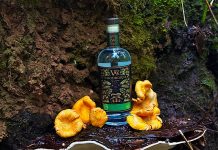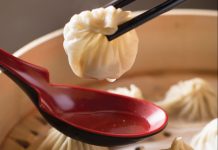Shelton resident, Pat Gilbert, describes his first encounter with mushroom hunting over 25 years ago as the catalyst for a personal, intellectual awakening and commitment to forest stewardship. After that first time looking for morels in the forests of Michigan, he explains that he was compelled to continue returning to the forest out of a “deep curiosity for the multitude of species that are out there.”
 Since then, the self-described mechanic and nature-lover has shared his passion for mushroom hunting with others in addition to turning this hobby into a source of supplemental income. Fortunately, there is perhaps no better place to pursue such an interest than in the Puget Sound area – a plethora of edible, wild varieties grow throughout the season, ranging from the common and easy-to-spot yellow chanterelle, to the rare black trumpets, to the uniquely aromatic matsutake. “The abundance here is nearly unparalleled,” Pat’s partner Ricki comments, making mushroom foraging a pastime appropriate for even the most casual of hunters who “have a love of going out into the forest and picking for the table.”
Since then, the self-described mechanic and nature-lover has shared his passion for mushroom hunting with others in addition to turning this hobby into a source of supplemental income. Fortunately, there is perhaps no better place to pursue such an interest than in the Puget Sound area – a plethora of edible, wild varieties grow throughout the season, ranging from the common and easy-to-spot yellow chanterelle, to the rare black trumpets, to the uniquely aromatic matsutake. “The abundance here is nearly unparalleled,” Pat’s partner Ricki comments, making mushroom foraging a pastime appropriate for even the most casual of hunters who “have a love of going out into the forest and picking for the table.”
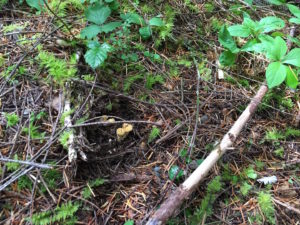
Just from talking to Pat, one can easily see how dedicated he is to mushrooms, especially as he describes potential medicinal uses of them as well as his attempts at the cultivation of several wild varieties. His knowledge is abundant, and he is more than eager to share it with anyone who has an interest.
As chanterelle season begins here in the Puget Sound area, some of his advice may prove to be helpful for newcomers looking to find some of their own golden mushrooms. When hunting for chanterelles, Pat stresses the importance of looking in a wet area that has received both sun and rain. When you are looking for patches, secondary growth coniferous forests are best with trees that are within the 40-150 year range. He also mentions that ravines or the intersection of two hills are often a good place to find these mushrooms. The season for chanterelles runs from mid-summer well into fall, stopping around November once the forest floor begins to reach colder temperatures.
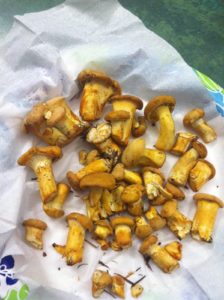
Although eventually the chanterelles wind down, that only signifies the beginning of matsutake season. As the weather grows progressively colder and wetter, your chances of finding these smelly gems increase. Remarkable for their similarity to other, more poisonous varieties like the amanita, the matsutake is not a beginner’s mushroom – but it is well worth the hunt for their unique flavor. When exploring for these gems later on in fall, Pat recommends looking in old stands of fir or pine trees, and he says that once you smell a matsutake, you will be able to identify these mushrooms by that alone. Since these varieties tend to be hidden underground and covered by moss and dirt, feeling around in a suspect patch may be necessary. Additionally, depending on where you are hunting for these mushrooms, a permit may be needed due to overhunting of this variety in the past.
As far as his general ‘shroom hunting tips go, Pat urges an ethic of stewardship for any would-be mushroom seekers. “Don’t pick with your toes, especially around chanterelles,” he mentions, smiling. He further stresses the importance of collecting your bounty carefully, stating that part of the magic of mushrooms is their status as a delicacy. Therefore, picking only what the hunter needs is important if one does not have commercial aspirations.
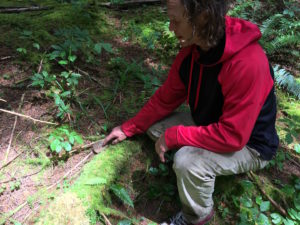
He also mentions that “field cleaning,” or cutting off the stems and any discarded mushroom parts in the patch in which the mushrooms were discovered, can help with the regeneration of the mushrooms in subsequent years. When it comes to identification, it is always best to consult an expert or a friend who is more knowledgeable when unsure of the variety. In the case of chanterelles, however, he stresses that there are very few lookalikes in the Pacific Northwest, and their distinctive appearance makes them a very good mushroom for beginners. For those who wish to see one in person before hunting on their own, Pat even suggests purchasing one from a specialty store and taking notes about the color, shape and distinct gills of the chanterelle. Once one sees these features in person, he may feel more comfortable with foraging.
Most interestingly, however, Pat urges mushroom hunters to see gathering wild mushrooms as a source of endless curiosity and wonderment. After all, Pat is still learning and searching for new mushroom varieties after 25 years of beginning this hobby. His current project? Hunting for truffles, which are typically harvested in winter in this area and can be very difficult to collect. “Sometimes they [mushrooms] are the hardest prey because they don’t move, so it always keeps me guessing,” he remarks. Considering the abundance of varieties and various benefits of mushrooms, you should consider that hunting one’s very own gourmet delicacies may prove to be an enjoyable addition to your next hike.






